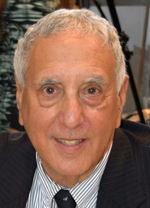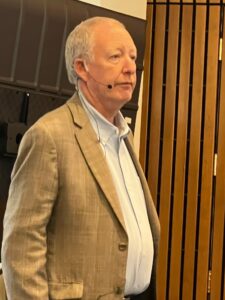By Donald H. Harrison


LAFAYETTE, California – San Francisco State historian Marc Dollinger said only one Jewish group – the Reform rabbis of San Francisco – publicly objected to the incarceration of Japanese-Americans during World War II. The rest of the organized Jewish community acquiesced to the imprisonment of these innocent American citizens, Dollinger said during the 18th annual Mimi Epstein Memorial Lecture at Temple Isaiah on Sunday, Dec. 4, here.
In contrast, the American Jewish community quickly objected and obtained a reversal of U.S. government policy during World War II that counted everyone holding a German passport as an enemy alien, he said. German Jews, these organizations pointed out, were not Nazis, but rather were the victims of Nazis.
Dollinger, the Goldman Family Research Chair in Jewish Studies and Social Responsibility at San Francisco State, lamented that most of the organized Jewish community looked only to protect their own, rather than to reach out to a fellow American group which was victimized by discrimination during the Second World War.
The Jewish Studies faculty member suggested that Reform Jews in San Francisco felt particularly comfortable in their identities as Americans – witness the large cathedral-like structures they built for their synagogues – and therefore were willing to advocate for such constitutional principles as equal protection under the laws. By implication, other elements of the Jewish community felt less secure in their status as Americans, and thus were unwilling to raise objections to this miscarriage of justice.
Dollinger said if you study the historiography of any ethnic group, you will see that the first generation of scholars typically will focus on the accomplishments of that group. This is true of Jewish historians, African-American historians, Asian-American historians, Latin American historians, and so forth, he said.
The second generation of historians, he said, will critically examine and often contradict the work of the first generation of scholars.
The third generation of scholars often will attempt to reconcile the two views, arguing that there is a middle ground of interpretation for that group’s historical experience.
Subsequent schools of historians may approach the subject in entirely different ways. They may delve into social histories, focusing more on ordinary people than acknowledged leaders, or they may try to write history from the viewpoints of people who have been often overlooked, particularly women.
Dollinger is a well-known historian, whose publications include a book he co-edited with Ava Kahn titled California Jews. One of the chapters in that volume, about San Diego, was written by retired Prof. Lawrence Baron of San Diego State University, who contributes political satire columns to this publication. Baron had served as the director of SDSU’s Lipinsky Institute for Judaic Studies.
The cover of California Jews shows a stained-glass window from San Francisco’s Congregation Sherith Israel, which depicts Moses with the Ten Commandments. However, he is not receiving the tabletsat Mt. Sinai; he is receiving it somewhere near the Yosemite Valley, with Half Dome in the background.
That California Jews have stood apart—and possibly in front of other American Jews – also was illustrated by a slide in which two Jewish women, both Democrats from the San Francisco Bay Area were elected in 1992 to the U.S. Senate: Barbara Boxer and Dianne Feinstein.
*
Donald H. Harrison is editor of San Diego Jewish World. He may be contacted via donald.harrison@sdjewishworld.com